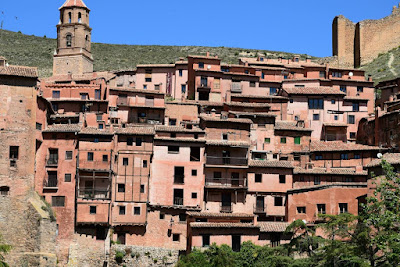We arrived two days ago from the coast, near Valencia, where
we were visiting old neighbours who have settled in Spain.
Albarracin is in the central mountains about 150 miles
inland, and has been described as one of the most beautiful towns in Spain. It
certainly has a long history, starting as a Roman settlement and then becoming
a regional centre under the Moors following their conquest of Spain that
started in AD 711.
We can see part of the old town from the campsite located about half a mile out of town.
Getting into the town itself, it’s a maze of different
levels, small streets and alleyways, for example:
There are some open spaces, this square for instance. We
expected to see a number of cafes and restaurants but there were none except
for fine dining hotels offering a full luncheon menu. We just wanted a coffee. The
square is very picturesque, though, with its balconies.
Now we’re looking at the cathedral. The tower dates from a
later century (15th) but looks very much in keeping with the rest of
the older buildings with its distinctive Moorish appearance.
From higher up we can marvel at the city walls as they rise even
further at impossible angles.
A passing couple took a rare photo of us together. The view
looks down into the newer part of the town towards our campsite in the
distance.
Another reason for the success of the town is its amazing
defensive position. It’s built on a crag almost totally surrounded by a loop in
the river. A zoom picture down to the river shows a simple water wheel for
irrigation onto the non-fortified bank where there is some sparse agriculture.
The lasting impression has to be one of the higgledy-piggledy
buildings. As rickety as they seem, they must have some substance having
endured all these centuries.
On the walk back to the site we spotted a flock of large birds wheeling high in the sky. We counted 11, and managed a telephoto shot of one of them which the book identified as a black vulture. These birds can have a wingspan of over 9 feet – so stay as high as you like, guys!











No comments:
Post a Comment